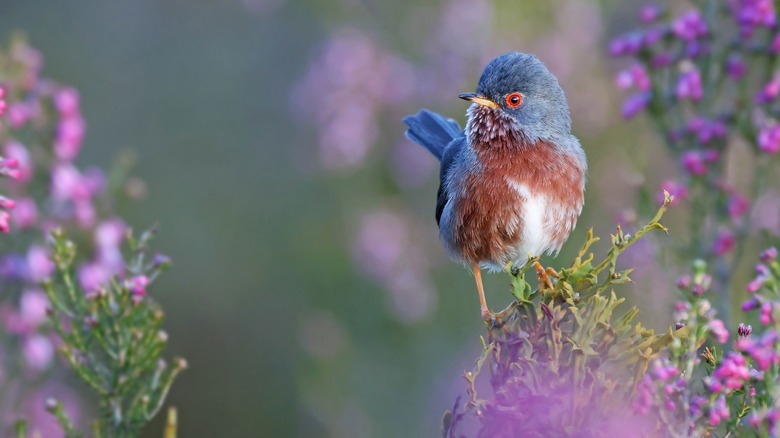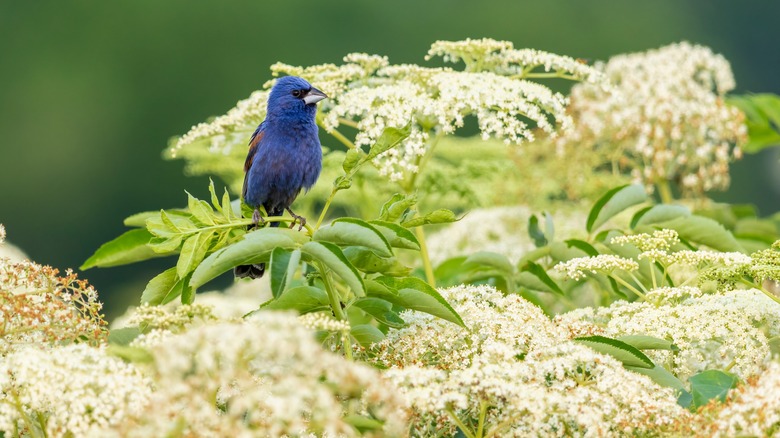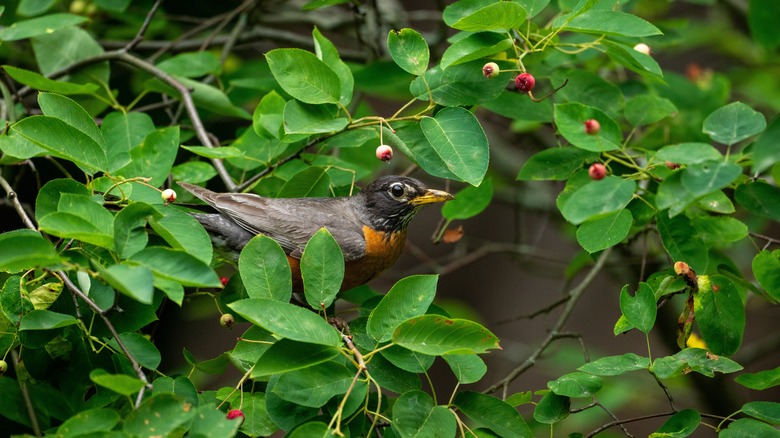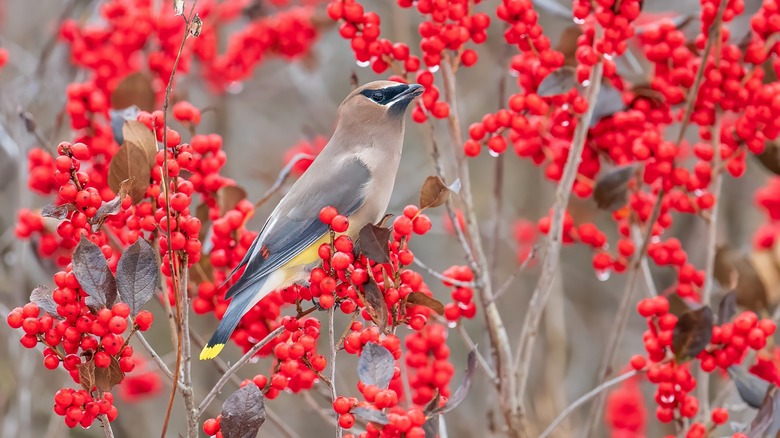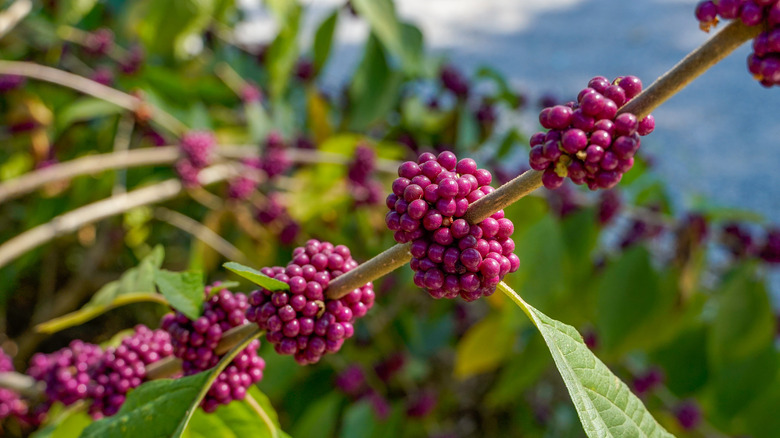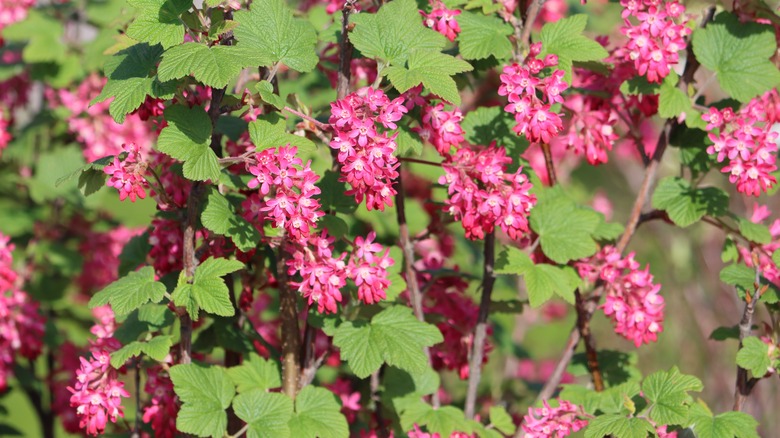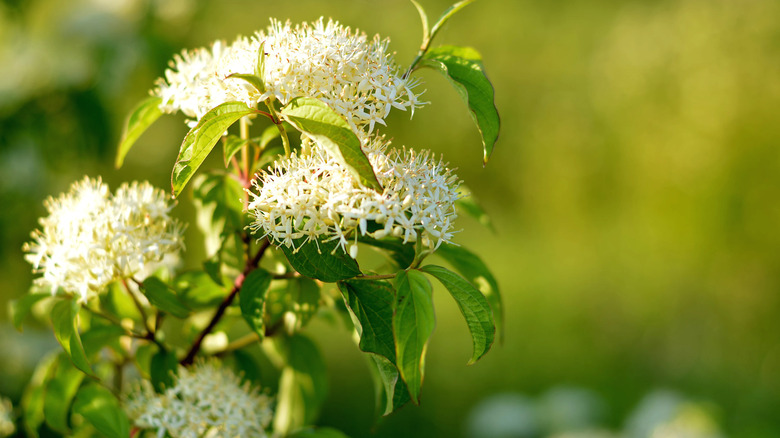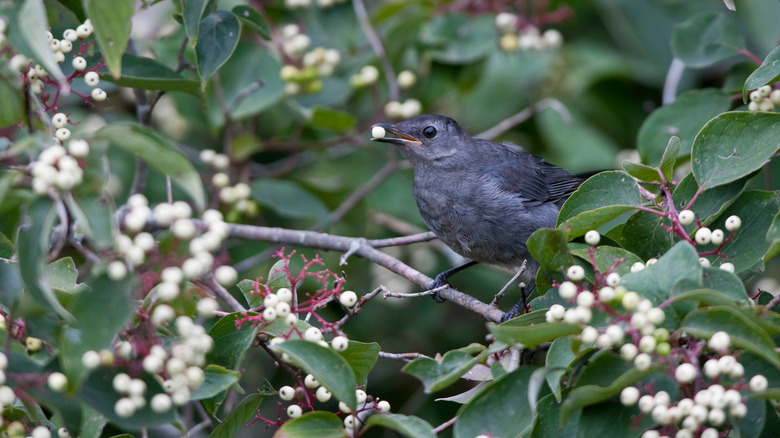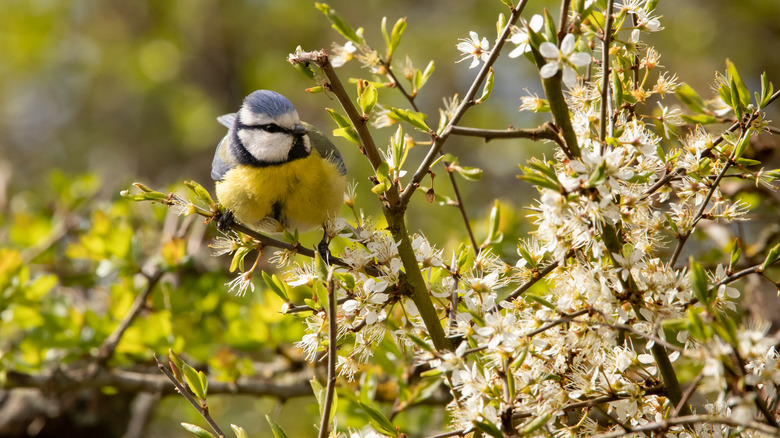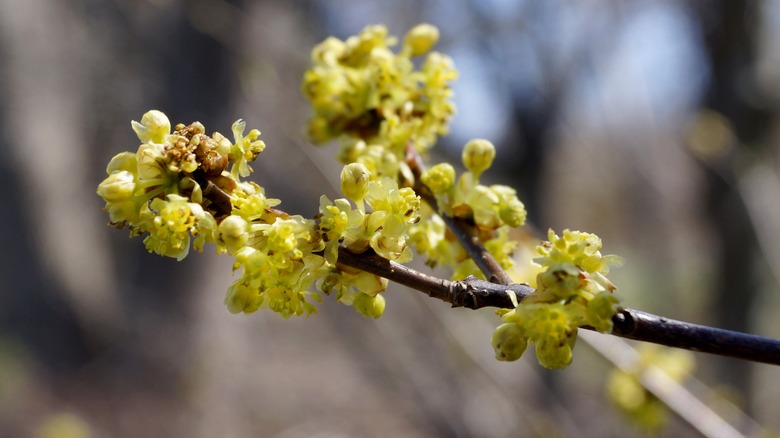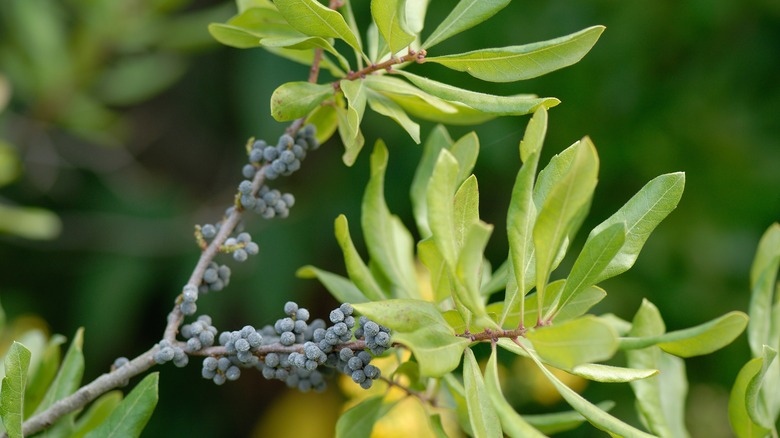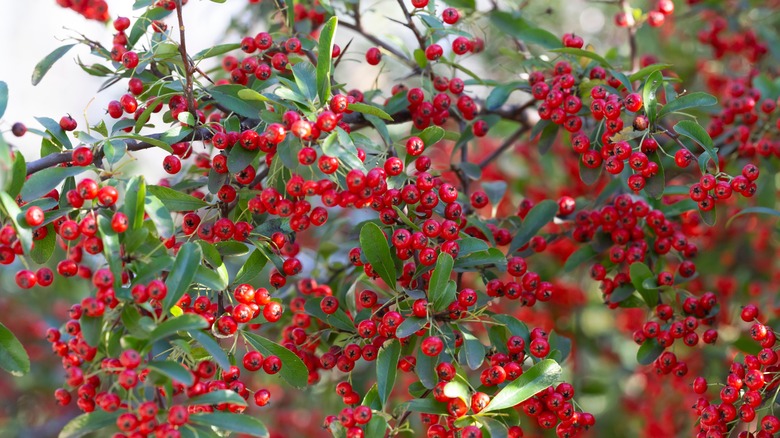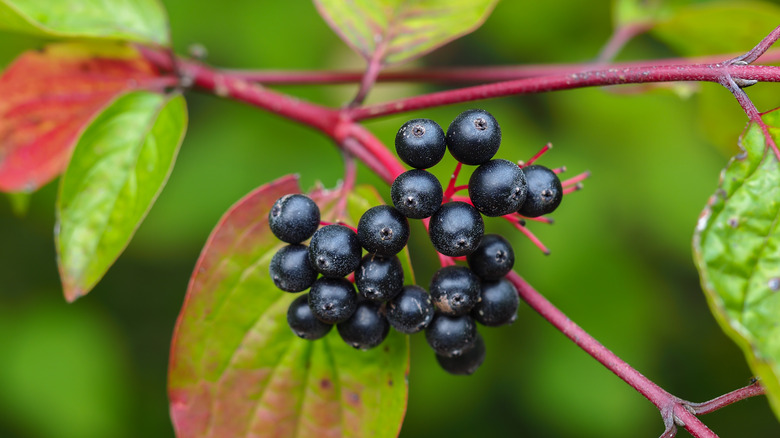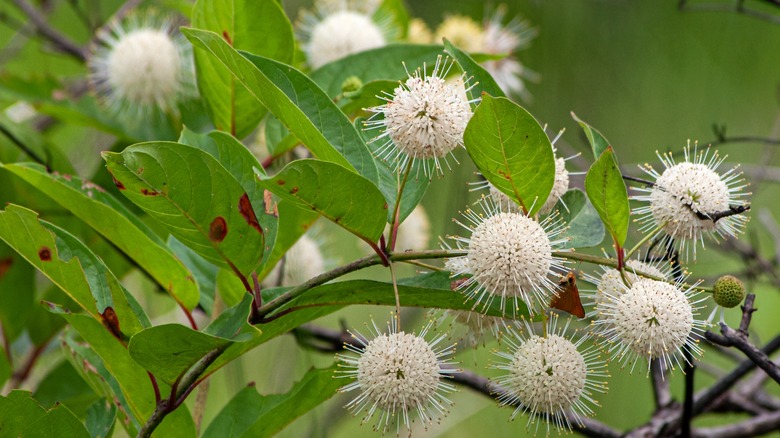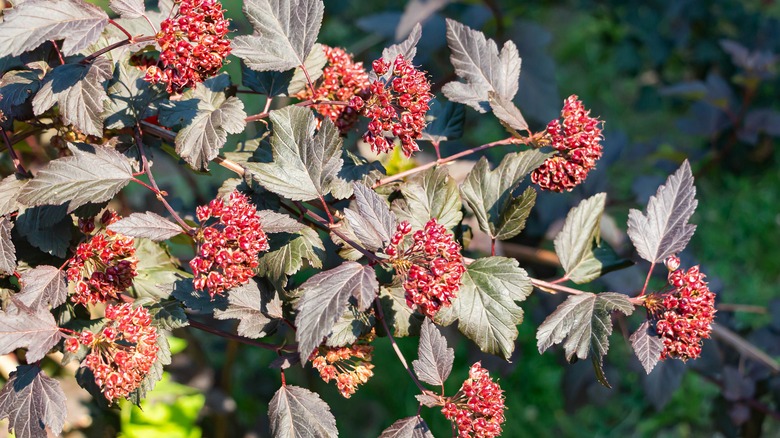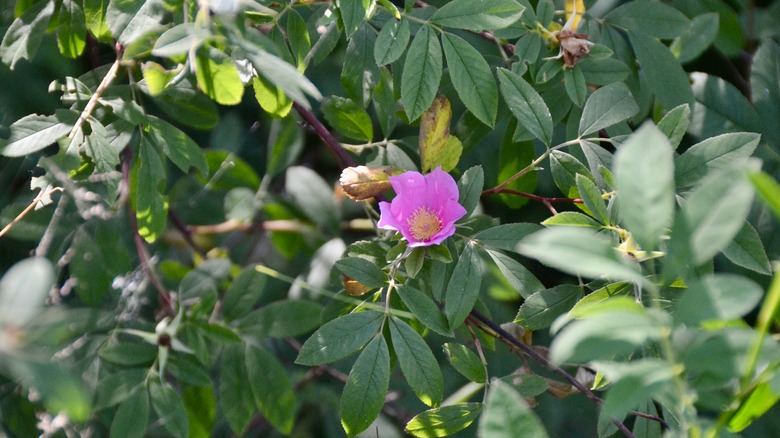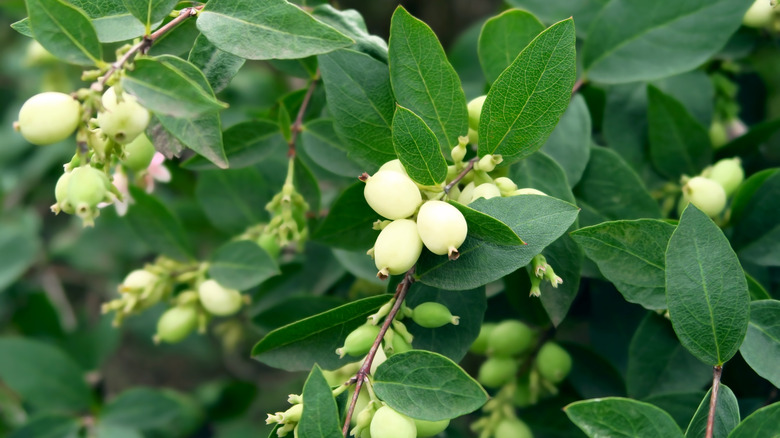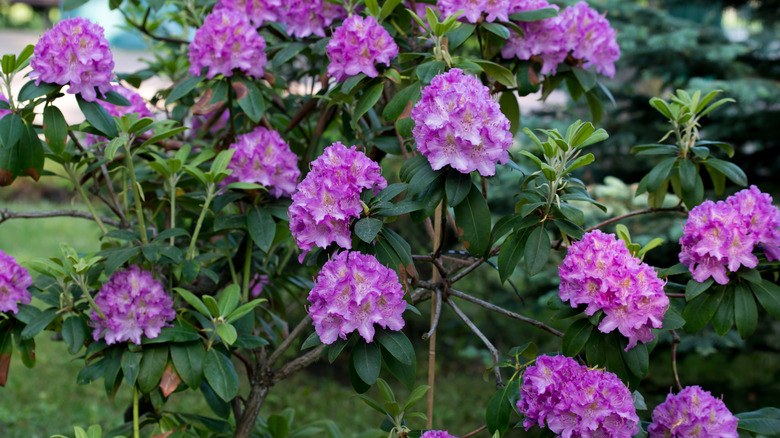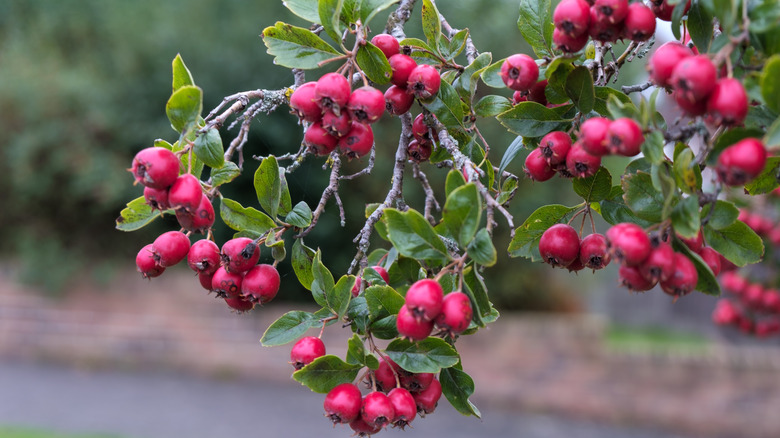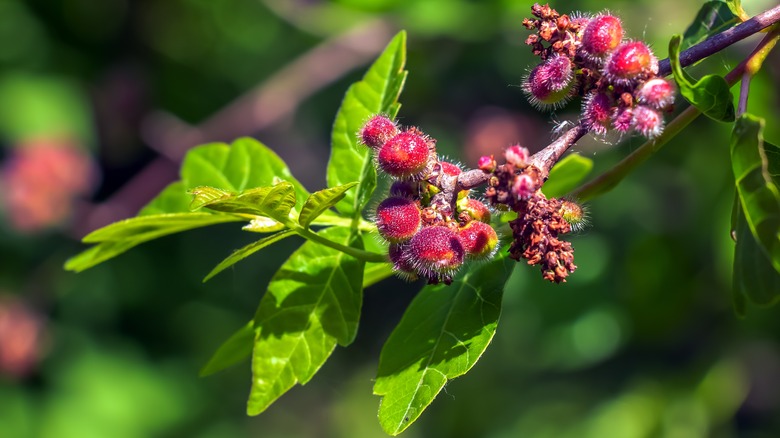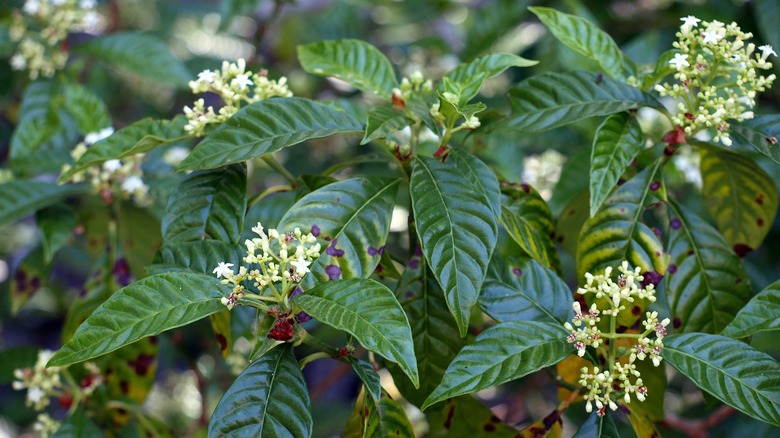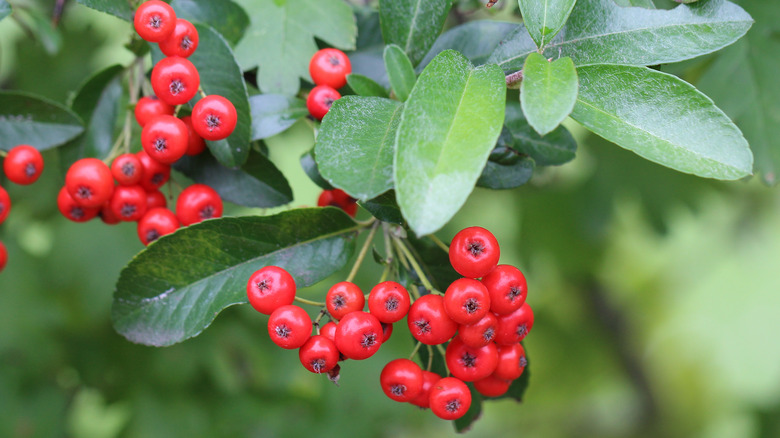21 Shrubs That Will Attract Birds To Your Yard For Fun Feathered Sightings
Attracting wildlife like bees, butterflies, and birds adds a touch of magic when creating your garden. Although the plants you add offer their own source of beauty, the insects and animals transform the landscape into something out of a fairytale. Planting shrubs is a great way to attract birds to your garden and yard for several reasons. Trees and shrubs act as safe havens, providing places for birds to hide from predators and keep a watchful eye for any potential threats. The stems inside bushes give them a spot to build nests for their young, helping to prevent population decline for several species. Additionally, these plants host small insects and caterpillars, providing birds with even more daily fuel.
Because different species seek out varying sources of nutrition, coverage, and nesting sites, start by choosing a variety of shrubs to meet these diverse needs. For example, hummingbirds will be more drawn to flowering types to drink nectar, like catawba rhododendron (Rhododendron catawbiense), while songbirds will prefer shrubs with lots of berries, like common elderberry (Sambucus canadensis). As we support them, birds bring their own set of benefits in return. While they enjoy the nutrition from berries and seeds, birds also consume several unwanted pests, such as mosquitos, aphids, earwigs, and more. Some species, like finches and sparrows, munch on weed seeds, acting as natural weed control. So, here are 21 shrubs to choose from.
1. Elderberry
Elderberry (Sambucus canadensis) is a must-have plant for gardeners who enjoy watching an array of wildlife. Pollinators like butterflies are particularly fond of its clusters of delicate white flowers that appear in the spring. This shrub can grow 12 feet tall, which makes it the perfect nesting spot, and provides nutrition for over 120 bird species, including ground-dwellers like bobwhites and several songbirds like robins, bluebirds, throated flycatchers, tanagers, and more. Other animals like squirrels also enjoy munching on the berries. Elderberry plants are hardy in zones 4 to 9 and do best in full sun.
2. Serviceberry
Growing up to 60 feet tall, serviceberry (Amelanchier arborea) provides perfect branches for species like cardinals and robins to nest. Not only is the dark green foliage stunning, but the leaves provide an ideal spot for certain types of butterflies to lay eggs. By fall, the green transforms into a bright orange-red shade, making it a good alternative to the invasive burning bush. In the summer, its reddish-purple berries attract an array of birds, including waxwings, mockingbirds, catbirds, tanagers, grosbeaks, and more. Most serviceberry shrubs are hardy in zones 4 to 9 and grow in partial shade to full sun.
3. Winterberry
Known for its showy red berries, the winterberry (Ilex verticillata) is a native deciduous shrub hardy in zones 3 to 9. It can tolerate a range of soil conditions, making it suitable for many gardens. Its fruit display is not only picturesque but also an important food source for several bird species, such as wood thrushes, gray catbirds, bluebirds, and robins, during cooler months when food is scarce. However, you'll need both male and female plants to get fruit. Its dense branches also offer shelter and nesting sites, making winterberry a considerable choice when creating a bird-friendly yard.
4. American beautyberry
With stems covered in clusters of vibrant pinkish-purple fruits, the American beautyberry (Callicarpa americana) truly lives up to its name. Not only does the shrub add a splash of color to your landscape, but mockingbirds, robins, towhees, and cardinals will flock to your yard for berries on this beautiful bush. Its dense foliage also provides excellent cover for small birds and animals looking to stay safe from predators. Hardy in zones 7 to 10, this fast-growing native shrub is often readily available in garden centers and is relatively low-maintenance. Even better, its leaves contain compounds that may repel pests like mosquitos and ticks.
5. Red-flowering currant
Clusters of pretty pink to red flowers, waxy blue-black berries, and vibrant shades of yellow or red foliage lasting from autumn through winter make red-flowering currant (Ribes sanguineum) a choice both animals and humans love. Its tubular flowers in bloom are like magnets to pollinators, specifically hummingbirds looking for early-spring nutrition. When fruit ripens in mid to late summer, you can expect to see several bird species like quail, grouse, woodpeckers, finches, robins, and towhees gobble them up. Natively found in the Pacific Northwest, this up to 12-foot tall and wide shrub is hardy in zones 6 to 8.
6. Pagoda dogwood
Boasting fragrant white flowers in late spring and dark blue berries that appear in mid to late summer, pagoda dogwood (Cornus alternifolia) adds visual appeal throughout the seasons. In colder months, snow effortlessly lands on its horizontal branches, highlighting its reddish-brown stems and creating a striking winter landscape. Birds like brown thrashers, northern cardinals, thrushes, eastern bluebirds, and American robins are drawn to its berries, and several species use its foliage for nesting. Hardy in zones 3 to 7, it thrives in moist, fertile, acidic, and well-drained soils. Though happiest in full sun, pagoda dogwood prefers some afternoon shade.
7. Gray dogwood
Although gray dogwood (Cornus racemosa) can grow aggressively if not pruned, its scraggly thickets make excellent nesting sites for several bird species. In late summer, bright red stems bear contrasting creamy white berries that provide a delicious, high-fat meal for nearly 100 bird species, and the seeds and buds are favorites of ring-necked pheasants and bobwhites. Additionally, as a larval host to some butterflies and moths, leaves crawling with caterpillars will catch the eye of hungry birds. Withstanding unfavorable soil types and tolerating shady areas, this hardy shrub can thrive in almost any garden in zones 3 to 8.
8. Green hawthorn
Native to the Southeastern U.S., the green hawthorn (Crataegus viridis) is hardy in zones 4 to 8. It thrives in rich, well-drained soil and does best in full sun, though it can tolerate a bit of shade. In spring, clusters of white flowers emerge before producing red fruit in the fall. Like many hawthorns, this variety does have a few small thorns, but this is advantageous for birds steering clear of predators. American robins, brown thrashers, northern cardinals, cedar waxwings, gray catbirds, and even wild turkeys will stop by and feed on the fruit.
9. Spicebush
The spicebush (Lindera benzoin) is a fast-growing shrub that grows best in a site with moist soils, though it can tolerate several soil types. Hardy in zones 4 to 9, this low-maintenance plant fills the air with a spicy scent when you break its leaves and stems. Because it's dioecious, each plant will have either male or female flowers, so you'll need one of each to get berries. When fruiting, it bears glossy, bright red berries in the fall, which are nearly immediately eaten by thrushes, American robins, gray catbirds, eastern bluebirds, and other species will also fly in for a treat.
10. Northern bayberry
Happily living in poor soils, growing northern bayberry (Myrica pensylvanica) is a breeze to master. Hardy in zones 3 to 7, these easy-to-grow shrubs thrive in part shade to full sun. Female plants produce waxy gray berries, or drupes, toward the end of summer, which are attractive to several songbirds. Yellow-rumped warblers love their fruit, and northern bayberry is one of the plants most likely to bring swallows to your yard. American robins, black-capped chickadees, eastern bluebirds, northern flickers, and red-bellied woodpeckers are among the other fliers who may grace your garden with their presence.
11. Red chokeberry
Red chokeberry (Aronia arbutifolia) is another stunning shrub that embraces the beauty of fall with its bright red foliage and glossy berries. Also offering clusters of butterfly-attracting white flowers in May, it provides year-round interest and supports local wildlife. In addition to the pollinators its fragrant blooms invite, the fruit is a hit with local bird populations. Look forward to spotting birds such as cedar waxwings, meadowlarks, catbirds, and more. Grow red chokeberry in zones 3 to 9, preferably with full sun, for the best fruit and flower production.
12. Nannyberry
Reaching heights of 18 feet tall, the tree-like nannyberry (Viburnum lentago) is a prime nesting location for several songbirds, such as warblers, catbirds, indigo buntings, and vireos. Its small drupes are ripe by late summer and will often continue through winter. You might spot other species like hermit thrushes, rose-breasted grosbeaks, and purple finches landing in the shrub for a cold-weather snack. Hardy in cooler climates 2 to 8, they're not too picky about soil as long as it's well-draining. Although they like full sun, they don't mind a little shade, either.
13. Buttonbush
Although buttonbush (Cephalanthus occidentalis) may be a bit thirstier than other varieties, you'll want this wildlife haven growing in your yard. These shrubs' incredibly unique spherical flower clusters may look like pin cushions, but are favored by several pollinating species. Look out for bees, butterflies, and hummingbirds who may stop by for a sip of nectar. It's not just hummingbirds that love this plant; over 24 species of birds are also attracted to this shrub. Grow it in zones 4 to 8, give it plenty of water and sun, and you can enjoy watching your new garden visitors.
14. Common ninebark
A drought-tolerant native, the common ninebark (Physocarpus opulifolius) loves to grow in well-drained soils and full sun to light shade. Native to the central and eastern parts of North America, this shrub is happiest growing in zones 2 to 8. Wrens, sparrows, cardinals, grosbeaks, thrushes, mockingbirds, orioles, finches, and other birds may visit your yard to find food and shelter. Not only do they find the berries appealing, but several species will take delight in gobbling up the seeds. Not only is it a hotspot for winged creatures, but its white or pink flowers, berries, and color-changing leaves add visual interest to your yard.
15. Swamp rose
As a member of the rose family, the swamp rose (Rosa palustris) enriches your garden with showy foliage and vibrant pink flowers in early spring to late summer. As the name suggests, this shrub is often found in swamps or marshes, though it makes an appealing addition to gardens in zones 4 to 9. By autumn, the foliage transitions into an attractive shade of red and yields berries that attract several species of birds, including thrushes, robins, cedar waxwings, cardinals, catbirds, thrashers, and northern mockingbirds. As a host plant to several moth species, birds can snag extra protein from the caterpillars.
16. Common snowberry
Common snowberry (Symphoricarpos albus) is a striking option for anyone looking to transform their yard into a wildlife haven. Its delicate pink bell-shaped flowers may be small, but they're loved by many pollinators, including hummingbirds. By late summer, the shrub yields greenish fruits that transform into soft, white berries. Songbirds like thrushes, towhees, robins, waxwings, and grosbeaks enjoy the winter snack. It grows in hardiness zones 3 to 7 and can tolerate some shade, though sunnier conditions aid in fruit production. Growing up to 6 feet tall, once established, this plant is drought-tolerant and low-maintenance.
17. Catawba rhododendron
Growing up to 20 feet tall, the Catawba rhododendron (Rhododendron catawbiense) displays showy lilac-colored funnel-shaped blooms that are a hit with pollinators. Not only is this a flowering shrub that will add drama to your yard, but it tends to be favored by hummingbirds more than other members of the rhododendron genus. Its dense thickets also make it a top-tier nesting spot for several species of birds and other animals. Hardy in zones 4 to 8, choose a site in your yard with dappled sunshine and moist, well-draining, acidic soil.
18. Possumhaw holly
Possumhaw holly (Ilex decidua) is a deciduous shrub that provides four-season visual interest. Its dark green oval leaves turn a purplish green to yellow when autumn arrives, which is when this shrub provides a food source to birds in the form of orange-red berries. Additionally, several moth species make the foliage their home, laying eggs that turn into caterpillar snacks for birds to enjoy. Grow this up to 15-foot shrub in zones 5 to 9, ideally with a male and female plant to enjoy its fruits. Sites with acidic soil and full sun to part shade make the perfect home.
19. Fragrant sumac
A modest-sized bush that reaches 6 feet tall and 10 feet wide, fragrant sumac (Rhus aromatica) is the perfect fit for smaller yards and those who still want to enjoy watching wildlife. Emitting a delicious lemon scent when crushed, this is a fresh-smelling plant that will bring mourning doves to your yard with its edible berries. The fruit also provides some cold-weather fuel for other birds, including turkeys and robins. Hardy in zones 3 to 8, this shrub can thrive in poor soil and shady conditions.
20. Wild coffee plant
The wild coffee plant (Psychotria nervosa) is moderately drought-tolerant but needs well-drained soil to thrive. As a Florida native, this plant does best in warm climates in zones 10 to 11. If you are in a state that has high temperatures year-round, you can give your yard added texture with this shrub's shiny green, prominently veined leaves, and vibrant red berries. The fruit is attractive to several mammal and bird species, like cardinals, catbirds, and mockingbirds. Its showy flowers are often visited by pollinators, including a variety of bee species and spicebush swallowtail butterflies.
21. Silver buffaloberry
Hardy in zone 3, the silver buffaloberry (Shepherdia argentea) is a cold-loving shrub that reaches heights of 14 feet. You may want to plant a couple, as you'll need both a male and female plant to produce fruit. Low-maintenance and drought-tolerant, the effort of planting multiple shrubs is well worth the reward. Being thorny and thicket-forming, it has all the ingredients to make an ideal nesting site for several bird species. Your favorite fliers will be like magnets to the bright red berries, so enjoy spotting songbirds who'll fill your yard with their playful music.
